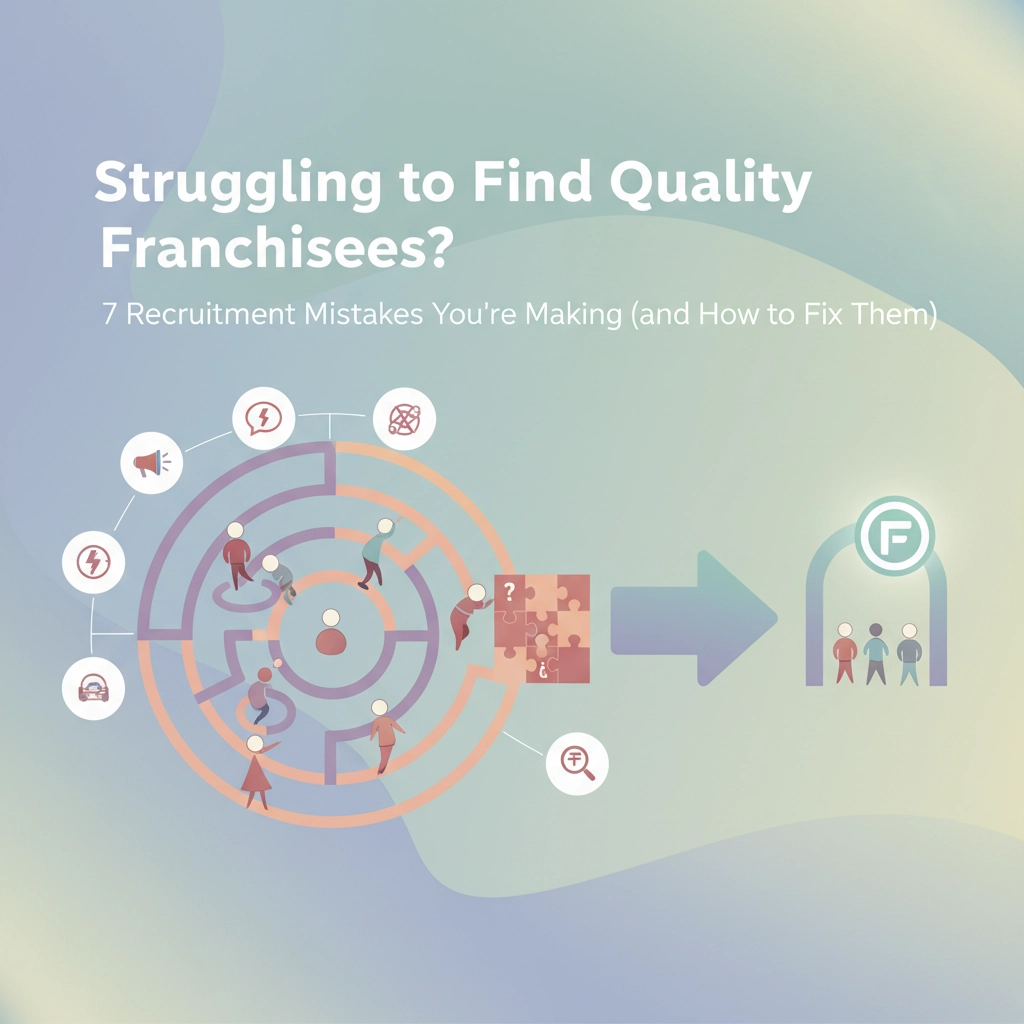Struggling to Find Quality Franchisees? 7 Recruitment Mistakes You’re Making (and How to Fix Them)

You’ve got a good business. The model works. People like what you do. Franchising feels like the next sensible step… and yet finding the right franchisees can feel like fishing with a spoon.
If the pipeline looks thin or patchy, don’t panic. Most franchisors trip over the same handful of things. They’re fixable. Think tweaks, not an overhaul.
Let’s walk through the seven most common slip-ups and how to sort them. No fluff. Just practical steps you can use on your very next call.
Mistake #1: Talking more than you listen
Easy trap. You’re proud of your brand, so you fill the silence. Meanwhile, the person who might invest can’t get a word in. That silence you rushed to fill? That’s where the useful stuff lives.
Why it hurts:
- You miss their real motivations (and red flags).
- You guess their finances instead of confirming them.
- You sell features they don’t care about.
Try this instead:
- Aim for the 80/20 rule: they talk 80%, you talk 20%. Yes, the quiet bit feels awkward at first.
- Use simple, open questions:
- What’s pushing you toward business ownership right now?
- What does “a good first year” look like for you?
- Who’s involved in the decision and what’s their view?
- Take notes. Real ones. You’ll thank yourself later.

Mistake #2: Weak follow-up (or none at all)
You have a great chat. Everyone nods. Then… nothing. A week later you’re both trying to remember what you agreed.
It’s essential to ensure you close each conversation with clarity. Even a tidy recap makes you look organised and trustworthy.
Make follow-up boringly reliable:
- Send a summary email within 24 hours. Bullet points, not an essay.
- Include:
- What they told you (goals, budget range, timing).
- What you promised (docs, dates, intros).
- What happens next (clear, dated steps).
- Add a quick “Does this match your understanding?” to keep you aligned.
Small note: if it isn’t written down, it didn’t happen.
Mistake #3: Winging the call
Unstructured calls drift. You run out of time. Important questions get missed. You hop off thinking “Great person!” but you have no data to back that feeling.
Keep it simple with a one-page plan:
- Send an agenda before the call:
- Quick intros
- Their goals
- How the model works (the 10‑minute version)
- Investment and funding
- Next steps
- Ask them what they’d like to add. People engage more when they help shape the conversation.
Don’t forget to park deep dives. If something needs 20 minutes, make it a separate step instead of derailing the call.
Mistake #4: Not digging into the five essentials
Surface-level questions get surface-level answers. You need to cover five areas properly. Quick definitions, then go deeper.
The five essentials:
- Vision and motivation: why now, and why this? If it’s “I hate my boss,” keep probing.
- System fit: do they like following a playbook, or are they allergic to instructions?
- Financial capacity: savings, funding options, safety net. No awkwardness—just facts.
- Decision timeline: who decides, by when, and what milestones matter?
- Criteria: their must-haves and deal-breakers (territory, hours, income targets).
Go one layer further on every answer:
- “Tell me more about that…”
- “How would you handle X if it came up?”
- “What would make this a no-go for you?”
Capture it all. Later, those notes are gold for both qualification and support.

Mistake #5: Playing judge instead of investigator
Some recruiters try to decide “yes/no” in the first ten minutes. It’s tempting. But snap judgements make you miss brilliant, slightly non-traditional candidates. (The best ops manager I ever hired had a music degree. Go figure.)
Shift the mindset:
- Your job on early calls is to understand, not to rule.
- Be curious, not combative.
- Use evidence, not hunches.
Talk track that helps:
- “Let’s see if there’s a fit on both sides.”
- “I’ll share what typically works well in our system—you tell me how that lands.”
It’s essential to ensure you trust your process more than your gut on day one.
Mistake #6: A fuzzy candidate journey
If candidates can’t see the path, they stall. Or they ghost you. (Not personal—just uncertainty.)
Create a clear, friendly road map:
- Stage 1: Quick fit call (15–20 mins). Basic criteria, next step agreed.
- Stage 2: Deep-dive chat (45–60 mins). Numbers, territory, day-in-the-life.
- Stage 3: Validation (speak to franchisees, review the manual outline).
- Stage 4: Decision support (funding options, legal review, Q&A).
- Stage 5: Commit and prepare (agreement, training dates, onboarding plan).
How to make it feel professional:
- Share the stages as a one-pager on day one.
- Use a simple tracker and confirm progress in each follow-up.
- Keep momentum with small, dated actions—no big mysterious gaps.

Mistake #7: Letting relationships go cold
Recruitment isn’t a one-call close. People think, compare, and (quite rightly) ask awkward questions. If you disappear between touchpoints, confidence dips.
Nurture without nagging:
- Send useful, short updates: a case study, a 2‑minute video, a territory map.
- Personalise: “You mentioned schools mattered—here’s the local demographic data.”
- Create safe spaces for honesty: “What’s worrying you right now?”
- Encourage validation: “Would you like an intro to two franchisees with similar backgrounds?”
Don’t forget: it’s essential to ensure transparency about risks as well as rewards. Invite them to stress-test assumptions and crunch numbers.
Build a better system (one small fix at a time)
This isn’t about perfecting your pitch. It’s about building a calm, clear process that helps good people make good decisions.
If you do nothing else this week:
- Audit one recent candidate journey. Where did it wobble?
- Add a standard follow-up template. Use it every time.
- Write your five essential questions on a sticky note by your screen.
Imagine candidates saying, “I always knew what was happening next.” That’s the goal. Professional, supportive, no drama.
The market is competitive, but steady beats flashy. Focus on fit, clarity, and consistent care, and the right people will find you—and stick around.
As ever, do your homework. Speak to existing franchisees. Get legal and financial advice before signing anything. And if you want a second pair of eyes on your process, ask for help. There’s no prize for making it harder than it needs to be.
Your future franchisees are out there. Make it easy for them to say, “Yes, this is for me.” Your network (and your sleep) will thank you.
